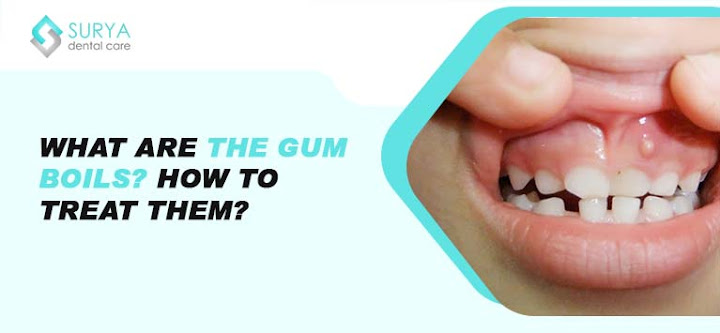
A gum boil is a swollen bump on the gum that is filled with pus. This boil develops as a result of bacterial growth or infection. This might be painful or sensitive over there. These bumps resemble acne that can get worse if left untreated.
In this blog, you will learn about gum boils’ types, causes, symptoms, and treatments.
What are gum boils?
A gum boil is a small lump that appears on the gums, also called an abscess. Bacteria is the main cause of this boil. This boil often develops when food particles, plaque, and decay accumulate, leading to mouth or gum infection due to poor oral hygiene. It is rarely a sign of oral cancer.
People with gum disease or those who have recently undergone dental treatment are more likely to experience them. They are typically treated with antibiotics and dental treatments.
Untreated gum infections have the potential to spread to other body parts.
Based on the bump’s location, it is categorized into three types.
- A gingival abscess is a localized, purulent illness that only affects the soft gum tissue close to the interdental papilla or the marginal gingiva.
- A periapical or Pericoronal abscess frequently occurs close to the crown or root of a tooth that hasn’t pierced your gums, such as impacted wisdom teeth.
- A periodontal abscess occurs when the gums are infected by bacteria found in the debris. The periodontal ligament surrounding the tooth’s root may become inflamed, causing it to break apart from the tooth’s crown.
Causes of a gum boil
Bacterial infections are the main culprit for both dental and gum abscesses. According to the National Health Portal, gum disease is brought on by bacterial infections which affect the teeth’s supporting bone and gum tissues.
It results from:
- Poor Oral Hygiene
- Crooked or misaligned teeth that are difficult to clean and maintain
- Smoking or consuming tobacco products
- Pregnancy, diabetes, or genetic susceptibility
- Poor nutrition
- Gum disease
- Pre-existing oral problems
- Tooth decay
Symptoms of gum boil
According to the research published by the IOSR Journal of Dental and Medical Sciences, the symptoms of gum boils may vary from slight to severe discomfort and swelling.
A few of the more common symptoms of gum boils include:
- Pain, soreness, swelling around gums or mouth.
- Bleeding or pus discharge coming from a boil or the gums.
- Bad breath
- An earache
- Sensitivity to cold or heat
- A fever
- Nausea
- Dysphagia (trouble in swallowing)
- Discolored teeth
- Drooling
- Hoarse voice
- Facial erythema (facial redness)
- Trismus (locked jaw)
How do you get rid of it?
Depending on the severity of the condition and whether it can be treated early on, there are different methods to treat gum boils.
Even though a dentist should always treat tooth or gum abscesses, there are a few home remedies that some people swear by.
Home remedies for gum abscesses
There are a few home remedies that are believed to treat unhealthy gums are following:
- Rinsing or gargling mouth with warm salt water or with garlic juice.
- The application of some essential oils as a type of topical treatment.
- Applying clove oil or tea tree oil on the affected area.
- Antibiotics that a doctor recommends.
- Using hydrogen peroxide mouthwash.
- Applying turmeric paste around the area.
However, most of these techniques are not medically reviewed, and in some instances, they may even cause an infection to spread. It is always better to consult a doctor if you have gum boils.
Professional Treatments
Natural home remedies and antibiotics are not enough if the infection is a symptom of an issue with a root canal or the health of the gum tissue. Conversely, getting professional dental treatment for gum abscesses is safer and most highly recommended.
In such cases, the infected area should be treated professionally by using the following methods:
- Deep cleaning, and scaling and root planing are both similar procedures that can remove tartar buildup, plaque, and active bacteria which harm your teeth and gums and keep your gums healthy.
- Drainage eliminates fluid accumulation in the abscess and is often performed after cleaning.
- Surgery might sometimes be required to remove if you have especially bad or severe boils.
- You need to get root canal treatment if the problem is in your canal. This involves disinfecting the infected teeth by removing any bacterial infections or tooth decay. A crown can be placed over the canal to avoid further infection.
Bottom line
A Gum abscess is never something you should ignore. It might lead to a serious infection in your teeth and gums. Good oral hygiene, like brushing your teeth twice and flossing daily, is the best protection against gum boils.
If you have an abscess, it is always important to visit your dentist. If left untreated, the infection may spread throughout the mouth and other body parts.



